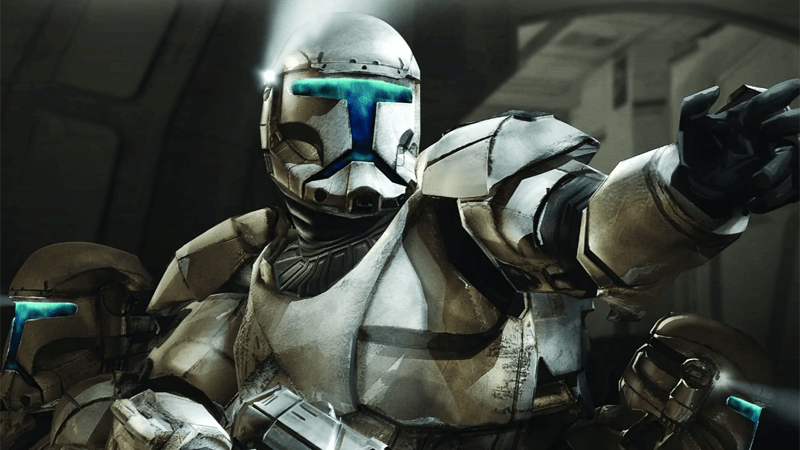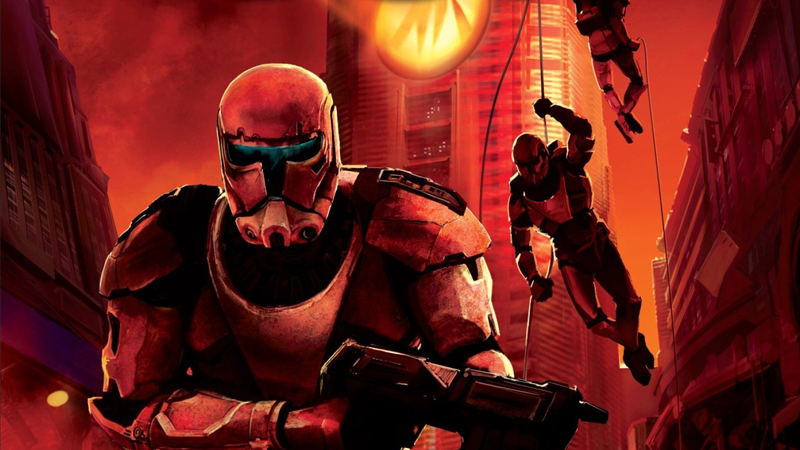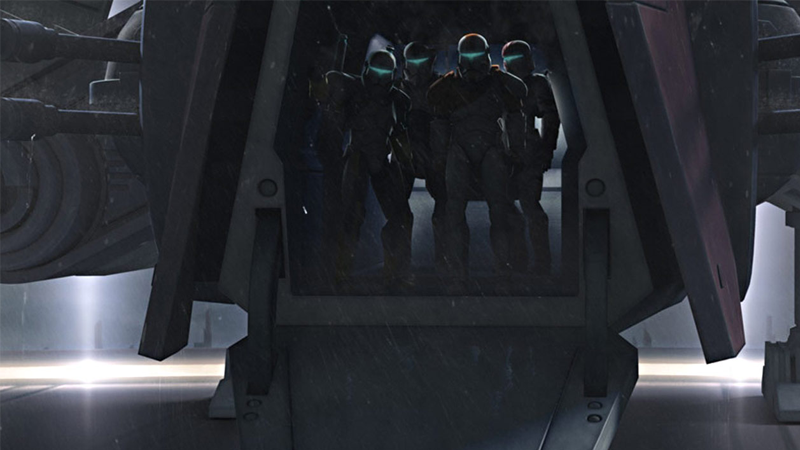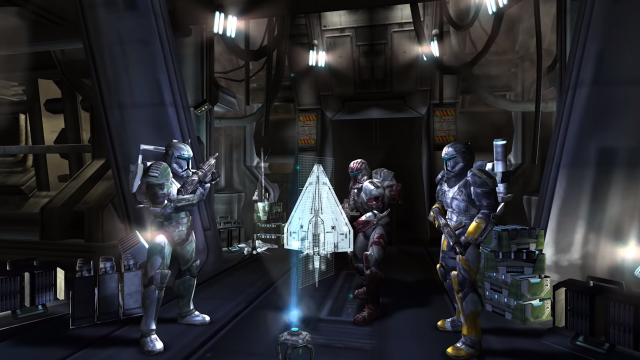There’s a paradoxical relationship between the legacy of one of Star Wars’ best games and the animated show that became one of the most beloved pillars of the franchise at large. Arguably, Star Wars: The Clone Wars killed Republic Commando at its apex — but without the groundwork it laid, the animated series and its own influences would never have been the same.
In just over a month, Switch and Playstation fans will get to relive Lucasart’s beloved 2005 shooter all over again — the first time the game’s been accessible on either platform (Xbox consoles have been able to play the original version via backward compatibility, so they’ll have to make do). The game itself is beloved for a reason and arguably sits as some of Star Wars’ best work in the gaming medium. It was a great tactical squad shooter that also told a fascinatingly intimate story about an elite group of Clone Commandos, all the way from the Grand Army of the Republic’s beginnings to the twilight of the Republic.
[referenced id=”1674829″ url=”https://gizmodo.com.au/2021/02/star-wars-republic-commando-redeploys-delta-squad-on-ps4-and-switch/” thumb=”https://gizmodo.com.au/wp-content/uploads/2021/02/25/zolusca1h819dcph7coj-300×169.jpg” title=”Star Wars: Republic Commando Redeploys Delta Squad on PS4 and Switch” excerpt=”Before Dave Filoni’s Clone Wars cartoon unknowingly kicked off a huge part of the new Star Wars prequel-era canon, our best look at the lives of the clone army came from 2005’s Republic Commando, a semi-tactical first-person shooter now hailed as one of the best Star Wars video games ever…”]
It treated the squad — Boss, Scorch, Fixer, and Sev — as brothers, beyond their Clone heritage or as soldiers in battle but to forge a truly familial link. It was a bond tested by Republic Commando’s darker, grounded look at the Clone War, away from the heroics of Jedi Generals and sweeping battlefronts to the grimy shadows that special forces operated in. But Republic Commando never got the chance to say more. A planned sequel, set after the events of Revenge of the Sith and called Imperial Commando never got past the concept phase, and was scrapped. As a video game series, its legacy is restricted to being a fondly remembered one-off. Instead, it would take another path to embed itself within Star Wars ephemera much more profoundly, in a manner still felt today even after the de-canonisation of the old Expanded Universe: tie-in books.

Released four months ahead of the game, Republic Commando: Hard Contact was the first Star Wars novel penned by Karen Traviss. Although it had loose hooks into Republic Comando as a game — one of the book’s main Clone characters, Darman, was part of a squad referred to in radio chatter in the game before joining his “mongrel” unit of survivors in Omega Squad — Traviss’ book starred an altogether different cast of Clones. But it took the similar aims of the game’s story and ran with them, forging a bond not just between the Clones of Omega Squad, but the increasingly disillusioned Jedi that cross their paths. And, perhaps most crucially to both Republic Commando’s legacy and its downfall, that also included the Mandalorian tutors that followed in Jango Fett’s footsteps to transform the Clone’s genetic template into a shared cultural heritage.
That’s the thing about Traviss’ novels, aside from being some of the closest parallels to hard military sci-fi you could get in Star Wars’ fantastical worlds: it treated its Clone heroes as more than just Clone Troopers and more than just humans with lives beyond conflict. The books made them Mandalorians, as devoted to the familiar warrior culture of legend as they were to a Republic they and their Jedi allies grew increasingly untrusting of. They got married (the aforementioned Darman married the Jedi Padawan Etain Tur-Mukan — Anakin Skywalker eat your heart out!), had children, and dreamt of a retirement on what they now saw to be their homeworld — not the laboratories of Kamino, but Mandalore. By the time Traviss’ series got to the tragic events of Order 66 her heroes were complex, haunted figures, far more than the grunts on the front line that the Republic’s soldiers could be in stories more interested in lightsabers and the force’s role in the Clone War. She reframed its entire impact to not be on the fall of the Jedi but the fracturing of this desperate unit of brothers and their wider family who wanted the hell off this galactic trainwreck.

But then the second season of Star Wars: The Clone Wars happened. And Republic Commando, on the precipice of transitioning into a series about the Rise of the Empire, imploded. Initially, Traviss’ relationship with Clone Wars was amicable. She penned the official novelisation of the 2008 movie that kicked the animated series off, bringing her expertise at depicting the Clones she had honed in the Republic Commando saga to flesh out the story around Jabba the Hutt’s son being kidnapped. But Clone Wars’ second season brought with it a major shock: for the first time in proper canonical material (media with the direct involvement of Star Wars head honcho George Lucas) we would visit the world of Mandalore. And it was unlike anything Traviss or legions of writers before her in the Expanded Universe had been envisioning for, at that point, decades of stories.
The Mandalorians of Clone Wars were not honour-driven warrior castes — they had in fact driven those who stood by that culture out, part of a civil war and reformation effort that created the current Mandalorian power structure we first meet in 2010’s “The Mandalore Plot.” Mandalore was no longer ruled by a Mand’alor, but a Duchess, Satine Kryze, and she lead the New Mandalorians, an isolationist pacifist movement that overhauled Mandalorian society into a democratic, peaceful neutrality. The kinds of Mandalorians Star Wars fans had spent years reading about, in Traviss’ novels included, were branded terrorists, exiled off-world only to exist as antagonistic forces like the Death Watch. Suddenly, the Mandalore Traviss’ Clones dreamed of, that had inspired their rich adoptive history, didn’t exist. The Republic Commando series couldn’t square the circle, and in the old, arcane tier system of Expanded Universe canon, it was downgraded with Clone Wars’ precedence.

Citing a combination of the overhauls to Mandalorian canon and contractual issues in a 2010 interview with Gizmodo, Traviss officially cut ties with Lucasfilm. Imperial Commando, the first book in Republic Commando’s Rise of the Empire era, was left without a sequel, one intended to conclude the series that had become a standout star in the contemporary expanded universe. Years after, when Disney purchased Lucasfilm from George Lucas and decided to overhaul Star Wars canon for a new era, it was consigned to legend.
And yet, Republic Commando’s ethos persists in Star Wars as we know it today. Clone Wars itself did things like re-integrate the Clone Commandos back into canon with characters like Gregor, even Delta Squad, and eventually Clone Force 99 in the show’s final season (a.k.a. the Bad Batch, now the titular stars of the upcoming spinoff animated series), of course. But beyond that, it explored Clone identity and kinship in ways — while not necessarily as morally complex or so deeply-focused as Traviss’ novels — that touched on familiar themes of life outside of the Republic construct, of loyalty and brotherhood and the individuality of the Clone Legions.

Beyond that, the Mandalorian culture Traviss had helped cultivate in her books that Omega Squad became intrinsically connected to has managed to slowly resurface in prominence once more with the advent of Disney+’s The Mandalorian. Characters like Din Djarin and Bo-Katan Kryze (who herself began her story in Clone Wars, before appearances in Rebels and eventually the live-action streaming series), who both had strong links to the warrior-ideologies of the Death Watch inspired by the race’s past depictions in the EU, almost became the defacto image of the Mandalorians in fandom consciousness again as the show rocketed into the mainstream over its first two seasons.
And so, Republic Commando stands on the precipice of being introduced to a new generation of Star Wars gamers, alongside those who loved it a decade and a half ago. But the legacy it left behind feels so alive and well, that it feels like a warm welcome back — even if the books that established that legacy are now stories of a bygone Star Wars era.
